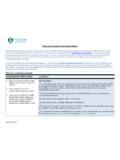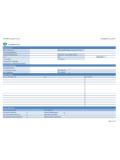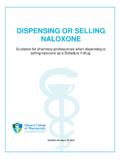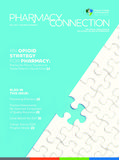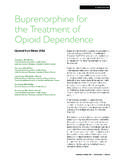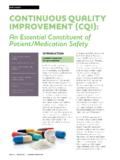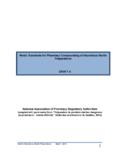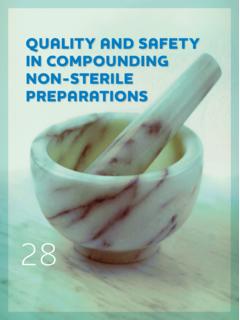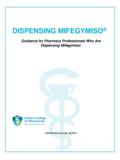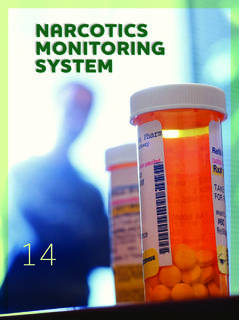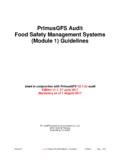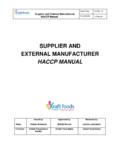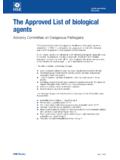Transcription of Community Pharmacy Assessment Criteria - …
1 1 Community Pharmacy Assessment Criteria . Updated January 2018 Community Pharmacy Assessment Criteria The following chart outlines the Community Pharmacy operations Criteria that are used by Community Practice Advisors (CPAs) when conducting a Community Pharmacy Assessment . The document is divided into categories and for each category specific standards, which have been taken from relevant legislation, policies, guidelines or standards of practice, is identified with a link to the appropriate reference. The guidance section illustrates specific insights or activities required to ensure adherence to the standard and is provided to assist practitioners in understanding expectations and preparing for a practice Assessment . If you have received notice of an upcoming Assessment , complete this document and have it ready to share with your CPA when they visit. Ensure all staff members are aware of where the completed form is located should you not be present on the date the CPA visits.
2 For each standard, check the guidance that your Pharmacy has in place and work on achieving the remaining Criteria prior to the CPA visit. Some of the guidance may not apply, and is listed for informational purposes should you need it to help prepare your Pharmacy for your upcoming Assessment or to ensure that your Pharmacy is up to standard. Category: General STANDARD GUIDANCE The name of the Designated Manager or certificate of registration is clear and displayed in the Pharmacy . Reference: DPRA, (3) The name of the Designated Manager or certificate of registration must be clear and displayed in the Pharmacy . The DM certificate template is available on the OCP website. The College must be notified of a change in Designated Managers. The Acknowledgement of Change of Designated Manager Form can be found on the OCP website. There has been no material change to the size or physical layout since the certificate of accreditation was issued other than a change that was approved by the College.
3 Reference: DPRA, O. Reg. 264/16, The changes in the accredited area that occurred must be forwarded to the College using a Notice of Renovation Form located on the OCP website. All required signs are displayed as per legislation. Reference: DPRA, O. Reg. 264/16, The Point of Care symbol in its unaltered trademarked form must be prominently and appropriately displayed so as to be easily visible to the public either before entering the Pharmacy or immediately after entering. The Notice to Patient sign must be posted in an area where it can be easily seen by a person presenting a prescription. The Usual and Customary Fee sign must be posted in an area where it can be easily seen by a person presenting a prescription. 2 Community Pharmacy Assessment Criteria . Updated January 2018 The Point of Care symbol can be ordered by sending an email to The Notice to Patient and Usual and Customary Fee signs can be ordered by sending an email to The College must be notified of a change in Dispensing Fee.
4 Please send an email to Pharmacy Staff should review the Policy - Required Signage in a Pharmacy located on the OCP website. Category: Drug Schedules STANDARD GUIDANCE Schedule I, II and III drugs are sold under the conditions outlined in the DPRA, O. Reg 264/16, Part II. Reference: DPRA, O. Reg 264/16, Part II; SOP for Schedule II and III Drugs The Pharmacist must be physically present in the Pharmacy at the time of the sale of a Schedule I, II or III drug. All Schedule II drugs must be sold from the dispensary, where there is no public access and no opportunity for patient self-selection, after Assessment by a Pharmacist. The Designated Manager shall ensure that Pharmacy personnel are knowledgeable regarding the necessity of pharmacists to consult with patients about Schedule II products. The Pharmacy must develop a process to enable pharmacists to determine the appropriateness of Schedule II and III products for the Schedule III drugs must be available for sale in the Pharmacy from the dispensary or from an area within 10 meters of the dispensary.
5 A Pharmacist or Intern must be available for consultation with the patient. OTC Narcotics must not be visible to the public. Pharmacy Staff should review the Supplemental Standards of Practice for Schedule II and Schedule III Drugs located on the OCP website. Pharmacy Staff should review the National Drug Schedules located on the NAPRA website ( ) regularly for product scheduling. Pharmacy Staff should review the Article - Sale of Non-Approved Marketed Health Products ( Pharmacy Connection Summer 2014). 3 Community Pharmacy Assessment Criteria . Updated January 2018 Category: Standards for Accreditation STANDARD GUIDANCE The Pharmacy and dispensary meet the physical requirements outlined in the DPRA. Reference: DPRA, O. Reg 264/16, Part IV; Opening a Pharmacy Checklist The Pharmacy floor area must not be less than (200 ft ). The Pharmacy must have a separate and distinct patient consultation area offering "acoustical privacy". The Pharmacy must be constructed and finished in a manner which permits the effective cleaning of all surfaces including the walls, floors and ceilings.
6 The Pharmacy must be constructed in a manner that ensures patient s privacy and comfort is maintained. The dispensary must be designed, constructed and maintained so that it is not accessible to the public. The dispensary floor area must not be less than m (100 ft ). The dispensary must have a minimum work surface area of (12ft ) for preparation, dispensing and compounding of drugs adequate for the safe and appropriate operation of the Pharmacy . The dispensary must have a sink with hot and cold running water adequate for the safe and appropriate operation of the Pharmacy . The dispensary must have facilities and equipment available for the appropriate cleaning of utensils and equipment as well as a separate hand washing facility. The dispensary has the equipment necessary to meet the requirements outlined in the DPRA. Reference: DPRA, O. Reg 264/16, Opening a Pharmacy Checklist The dispensary must have equipment ( balance, consumable materials such as bottles, child resistant & light resistant vials, mortars & pestles, metric graduates, spatulas, ointment pad, etc.)
7 Necessary for the safe and appropriate operation of the dispensary. The dispensary must have a refrigerator that is of sufficient size to store only drugs (no food). All refrigerators that store medication must be maintained at a temperature between 2 and 8 C. The dispensary must have a device that has the ability to accurately display the temperature inside the refrigerator. The Designated Manager is responsible for ensuring all medications found in the refrigerator during a temperature variance are appropriate to dispense. Pharmacy Staff should be familiar with the Policy and Articles (Part 1 & 2) - Protecting the Cold Chain located on the OCP website. 4 Community Pharmacy Assessment Criteria . Updated January 2018 The Pharmacy has a computer system and access to library references that support the needs of your practice. Reference: DPRA, O. Reg 264/16, ; Required Reference Guide for Ontario Pharmacies ( Pharmacy Library) The Pharmacy must have a computer sy stem that includes a secure back up and recovery syst em.
8 The Pharmacy has accessible and appropriate resources available that enables practicing members to utilize the necessary resources to make therapeutic decisions. The Pharmacy must have access to the current required references as listed in the Required Reference Guide for Ontario Pharmacies located on the OCP website. The Designated Manager should review Pharmacy Practice Management Systems (PPMS): Requirements to Support NAPRA's Model Standards of Practice for Canadian Pharmacists located on the NAPRA website. Category: Standards of Operation STANDARD GUIDANCE The Pharmacy has operational processe s in place to ensure the safe handling, storage, and monitoring of medications to ensure patient safety. Reference: DPRA, O. Reg 264/16, The Pharmacy must have processes in place to ensure that dispensing is done under sanitary conditions (no direct contact with medications dispensed). The Pharmacy must have processes in place to ensure medications are stored in a safe, secure and appropriate manner and location.
9 The Pharmacy must have a process to remove expired/outdated prescription medications and chemicals (used for compounding) from the dispensing process (including automated packaging machines) in a timely manner. The Pharmacy must have a process to remove expired/outdated non-prescription medications from the Pharmacy . The Designated Manager should review the information about the Ontario Medications Return Program (OMRP) a program for the responsible disposal of health products returned by the public: The Designated Manager should review the Policy - Medication Procurement and Inventory Management located on the OCP website. Pharmacy Staff should review the Article - Implementing the Safe Handling of Oral Anti-Cancer Drugs (OACDs) in Community Pharmacies ( Pharmacy Connection Summer 2017). 5 Community Pharmacy Assessment Criteria . Updated January 2018 The Pharmacy has sy stems and procedures in place to ensure the se curity of controlled substances. Reference: NCR, s.
10 42 & 43 The Pharmacist must be responsible for ensuring that Narcotics in the Pharmacy are se cure. Safeguards include performing a narcotic reconciliation on a regular basis (at least every 6 months), with a change in Designated Manager and after a theft or robbery. The Pharmacist must be responsible for ensuring that Controlled Substances in the Pharmacy are secure. Safeguards include performing a controlled substances reconciliation on a regular basis (at least every 6 months), with a change in Designated Manager and after a theft or robbery. The Pharmacist must be responsible for ensuring that Targeted Substances in the Pharmacy are secure. Safeguards include performing a targeted substances reconciliation on a regular basis (at least every 6 months), with a change in Designated Manager and after a theft or robbery. The Pharmacist must take steps to identifying forgeries. Loss, theft and forgeries of N/CD/Targeted Substances must be reported to Health Canada- Office of Controlled Substances in Ottawa within 10 days.
